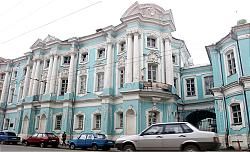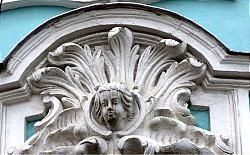A Palace Full of Secrets
Yulia Savelyeva, photo by Igor Tabakov
 Connoisseurs
of antique furniture may scour museums or antique shops for a priceless komod,
or chest of drawers, but rarely do they expect to find such an art form on
the streets of Moscow. However, those who have lingered long enough in
front of 22 Ulitsa Pokrovka, the house many Muscovites have nicknamed dom-komod,
have seen a chest of drawers on a truly grand scale.
Connoisseurs
of antique furniture may scour museums or antique shops for a priceless komod,
or chest of drawers, but rarely do they expect to find such an art form on
the streets of Moscow. However, those who have lingered long enough in
front of 22 Ulitsa Pokrovka, the house many Muscovites have nicknamed dom-komod,
have seen a chest of drawers on a truly grand scale.
A rare surviving example of baroque architecture from the era of Empress Elizabeth, or Yelizavetinskoye Baroque, the palace is one of Moscow's most interesting architectural landmarks.
The first half of the 18th century Ч running into Elizabeth's reign from 1741 to 1762 Ч was a fruitful period for baroque architecture in Russia. This development is linked directly to one man, Bartolomeo Rastrelli, the author of landmarks such as St. Petersburg's Winter Palace and Petrodvorets, or Peterhof Palace.
While many of these palaces survive in the northern capital, in Moscow the house on Pokrovka is the only outstanding secular relic of late baroque style. Examples of the palace's baroque decorations include the intricate white casings against its pale azure walls and its Corinthian columns. These details lend a rich and fluid rhythm to the facade, which is indeed similar to the centuries-old chest of drawers after which it is nicknamed.
And like the komods used by Moscow's elite to tuck away everything from family heirlooms to important documents, the house on Pokrovka has some secrets of its own. The most important mystery surrounding the palace is its architect, which to this day remains unknown. For years Rastrelli himself was considered to be the author of this house Ч perhaps because, in addition to its dom-komod nickname, locals also liked to call it the miniature Winter Palace.
But historical fact contradicts this legend. Rastrelli himself, a favored architect of the court in St. Petersburg, was too busy in the northern capital to busy himself with Moscow design. In fact, he only visited Moscow in 1741, the year of Elizabeth's coronation at the Kremlin's Assumption Cathedral. Furthermore, the house on Pokrovka, while similar in detail to Rastrelli's work, lacks the typical strictness and clearness of form so evident in the Italian's design. In recent decades art historians have changed their tune, settling on a more conservative answer to the question of the palace's authorship: "an unknown architect of the Rastrelli school."
Another mystery hidden in the house is the date it was built. A memorial plaque adorning the palace's walls indicate that it was constructed between 1766 and 1769, but once again historical fact seems to contradict these dates. By the late 1760s the demand for baroque was already fading, and classicism was quickly becoming the style of the day. Why, then, would anyone choose to invest money into building a palace that was already considered out of date?
It is, perhaps, more realistic to push back the date of construction to 1744, thus linking it to another legend connected to the palace. According to some historians, the house was originally intended as a wedding present from Empress Elizabeth to Alexei Razumovsky, the commoner she is believed to have married in secret. Whether or not this is the case, the building's design suggests it was built not in the 1760s, but in the 1740s.
While the house is steeped in legend, there are certain well-documented facts about it. The noble Apraksin family is recorded to be the original owner. In 1772 Count Matvei Apraksin sold the palace to Prince Dmitry Trubetskoi. Alexander Pushkin, whose relatives lived nearby on Khokhlovsky Pereulok, was a friend of Trubetskoi's son and as a child was a frequent guest in the house. Other prominent guests included poet Fyodor Tyutchev and his brother Alexander, the future Decembrist. And it was in this house that the parents of Leo Tolstoy announced their engagement. The writer's mother, Maria Volkonskaya, was Dmitry Trubetskoi's niece. Indeed, it is through this house that Pushkin and Tolstoy are distantly related: Pushkin's uncle was a second cousin to Ivan Trubetskoi.
 After
serfdom was abolished in 1861, Trubetskoi sold the palace to Moscow State
University. Soon thereafter the palace became home to a prestigious
gymnasium for young men. The school had many famous graduates, among them
world renowned theater director Konstantin Stanislavsky; his friend and
patron of Moscow's MKhAT theater, Savva Morozov; and Nikolai Zhukovsky,
the father of Russian aviation.
After
serfdom was abolished in 1861, Trubetskoi sold the palace to Moscow State
University. Soon thereafter the palace became home to a prestigious
gymnasium for young men. The school had many famous graduates, among them
world renowned theater director Konstantin Stanislavsky; his friend and
patron of Moscow's MKhAT theater, Savva Morozov; and Nikolai Zhukovsky,
the father of Russian aviation.
The school was disbanded after the 1917 Revolution, when for a time it served as the House of Pioneers and later even held communal flats. It was not until 1955 that the present occupant Чthe All-Russian Scientific Research Institute of Geophysical Methods of Prospecting Oil and Gas Ч was given the building.
In spite of its plaque identifying the palace as an architectural landmark protected by the state, the building has not undergone any serious repairs since the 1980s, when the foundation and the walls were strengthened with concrete. Since then some cosmetic repairs have been made from time to time, but the palace is, according to the director of the presiding institute, in need of costly renovations. It is, perhaps, time for the chest of drawers to find another secret investor.
ћатериал вз¤т с сайта www.moscowtimes.ru